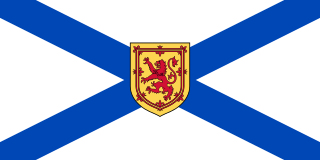Archibald Terris (November 30, 1873 – February 14, 1938) was a coal miner and political figure in Nova Scotia. He represented Cumberland County in the Nova Scotia House of Assembly from 1920 to 1925 and 1928 to 1933 as an Independent Labour member. Terris was a Labour-Conservative member from 1925 to 1928.

Nova Scotia is one of Canada's three Maritime Provinces, and one of the four provinces that form Atlantic Canada. Its provincial capital is Halifax. Nova Scotia is the second-smallest of Canada's ten provinces, with an area of 55,284 square kilometres (21,300 sq mi), including Cape Breton and another 3,800 coastal islands. As of 2016, the population was 923,598. Nova Scotia is Canada's second-most-densely populated province, after Prince Edward Island, with 17.4 inhabitants per square kilometre (45/sq mi).

The Nova Scotia House of Assembly is one of two components of the General Assembly of Nova Scotia, the other being the Queen of Canada in Right of Nova Scotia represented by the Lieutenant Governor of Nova Scotia. It is the legislative branch of the provincial government of Nova Scotia, Canada. The assembly is the oldest in Canada, having first sat in 1758, and in 1848 was the site of the first responsible government in the British Empire.
There have been various groups in Canada that have nominated candidates under the label Labour Party or Independent Labour Party or other variations from the 1870s until the 1960s. These were usually local or provincial groups using the Labour Party or Independent Labour Party name, backed by local Labour Councils or individual trade unions. There was an attempt to create a national Canadian Labour Party in the late 1910s and in the 1920s, but these were partly successful. The Communist Party of Canada, formed in 1921/22, fulfilled some of labour's political yearnings from coast to coast, and then the Co-operative Commonwealth Federation - Worker Farmer Socialist" was formed in 1932. With organic ties to the organized labour movement, this was a labour party by definition.
He was born in Hillsboro, Albert County, New Brunswick, the son of Asa Terris and Mary Giles, and was educated in Springhill, Nova Scotia. In 1895, he married Annie McDonald. Terris served as treasurer for a United Mine Workers local from 1922 to 1929. He died in Springhill at the age of 64.

Albert County is a county located in southeastern New Brunswick, Canada on Chignecto Bay in the Bay of Fundy. Prior to the abolition of county government in 1967, the shire town was Hopewell Cape. The county was established in 1845 from parts of Westmorland County and Saint John County, and named after Prince Albert.

Springhill is a community located in central Cumberland County, Nova Scotia, Canada.

The United Mine Workers of America is a North American labor union best known for representing coal miners. Today, the Union also represents health care workers, truck drivers, manufacturing workers and public employees in the United States and Canada. Although its main focus has always been on workers and their rights, the UMW of today also advocates for better roads, schools, and universal health care. By 2014, coal mining had largely shifted to open pit mines in Wyoming, and there were only 60,000 active coal miners. The UMW was left with 35,000 members, of whom 20,000 were coal miners, chiefly in underground mines in Kentucky and West Virginia. However it was responsible for pensions and medical benefits for 40,000 retired miners, and for 50,000 spouses and dependents.